In 2021, smart robots can supervise the efficiency of industrial robots by 30%.
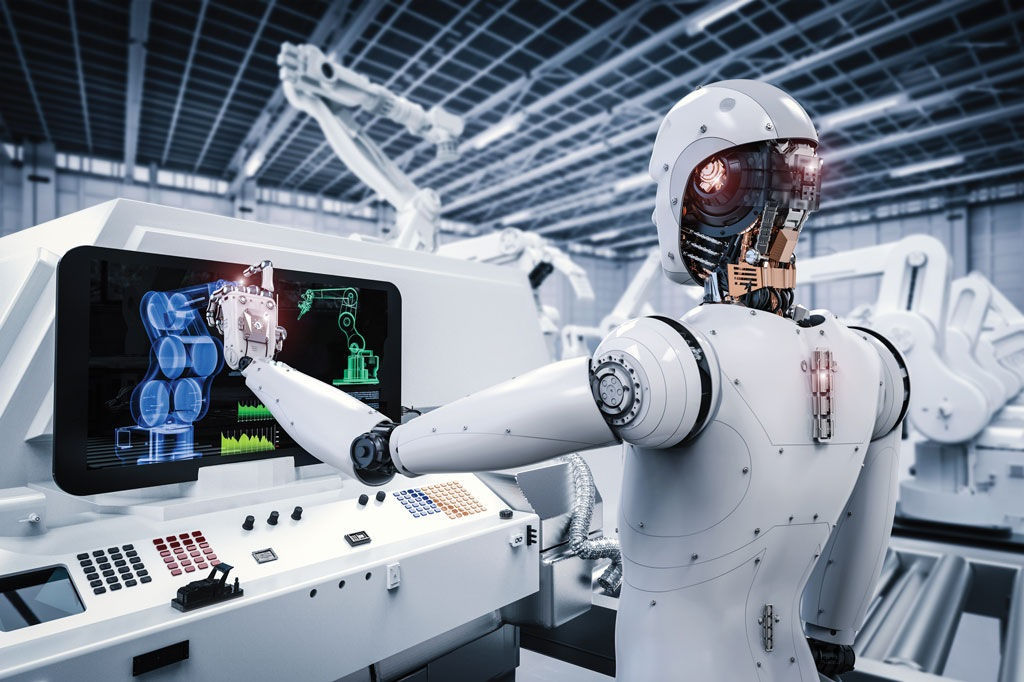
Robots that will help us suck the floor, act as a guide in public places, or dismantle bombs may be interesting, but those robots that are responsible for assembling cars and producing online jobs to pick up items in the factory are much more valuable overall, and There are also more and more industrial/commercial or consumer applications that are manufactured by such robots.
There are some recently published industrial robot trend research reports that the demand for industrial robots is growing in the Asian market, especially in the electronics manufacturing industry; and it is expected that in the next few years, technological advances will make these robots more capable. For example, the 2017 Industrial Robot Market Report released by the International Federation of Robotics (IFR) in Germany pointed out that the average annual growth rate of industrial robot unit sales in 2011-2016 is 12%, compared with 2015 in 2016. Growth of 16%.
From the perspective of regional markets, Asia is still the fastest growing in the global industrial robot market. In 2016, unit sales increased by 19%. During the same period, Europe and the Americas grew by 12% and 8% respectively. In 2016, the global industrial robot sales amount It is $13.1 billion. China has been the world's largest industrial robot market for several years, with an average annual growth rate of 31% between 2011 and 2016.
Although the top two industrial robot buyers in the world are China and South Korea, the highest market growth rate in 2016 was in China and the United States, with unit sales increasing by 27% and 14% respectively; followed by the Japanese market and the Korean market, growth rate. At 10% and 8%, Germany, which ranks the fifth largest industrial robot market in the world, has a flat sales performance. The above five countries accounted for 74% of global industrial robot sales in 2016.
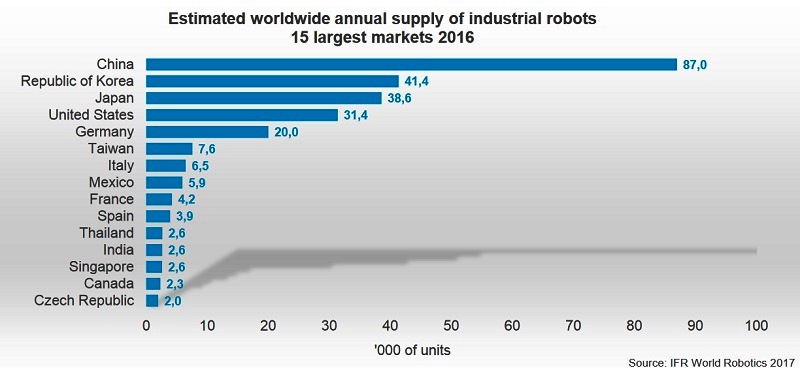
Top 15 Industrial Robot Markets in the World (Source: IFR)
From the application point of view, automobile manufacturing (35% market share) and electrical/electronic manufacturing (31% market share) have been the two largest industrial robot applications. Compared with the 6% growth rate of automotive manufacturing applications in 2016, electrical/electronic manufacturing applications have grown rapidly in the past few years, and industrial robot unit sales have reached 41% growth since 2015; in most Asian markets. Electrical/electronic manufacturing is also the largest industrial robot application area.
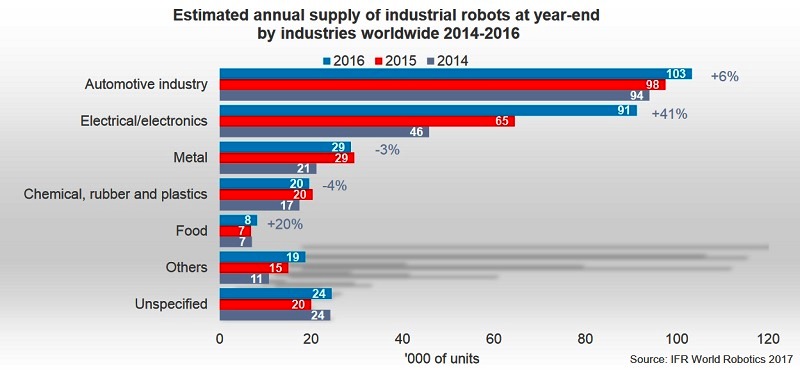
Automotive manufacturing is the largest application area for industrial robots (Source: IFR)
The IFR report also pointed out that it is very likely to be misleading to look at the overall industrial robot unit sales figures for specific markets and to ignore the manufacturing scale of each regional market/country; in order to provide more accurate analysis, the agency also counts The density of industrial robots per 10,000 employees in the manufacturing industry - the global average for this figure was 74 in 2016.
In terms of regional markets, European industrial robots have the highest density of 99, followed by 84 in the Americas and 63 in Asia. In terms of countries, Korea has the highest density of robots, reaching 631, followed by Singapore's 488, Germany's 309, Japan's 303, the US's 189, and China's 68.
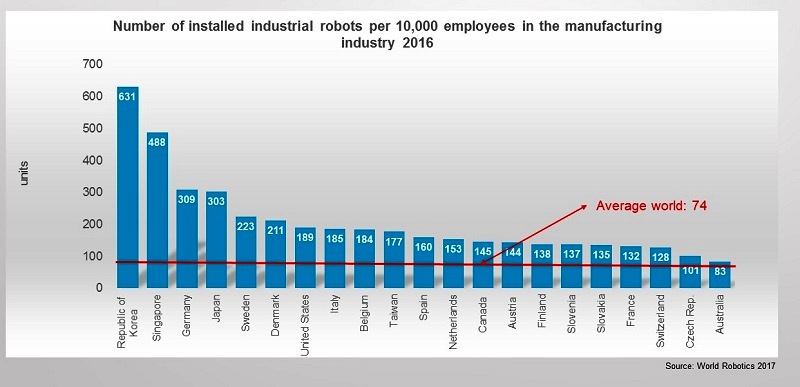
Number of robots per 10,000 employees in each country's manufacturing industry (Source: IFR)
Considering the total amount of robot purchases in China, the density of robots seems to be low. This figure has grown substantially compared with the 25 in 2013; however, it seems that there is still a distance for China to achieve the advanced manufacturing target of “ Made in China 2025 â€. Work hard. As for South Korea's global industrial robot density champion, it is because of the large-scale deployment of industrial robots in the country's electrical/electronic manufacturing industries such as LCD, memory and automobiles.
The IFR report pointed out that in terms of automobile manufacturing, the density of robots in the Korean automotive industry reached 2,145; while the density of robots in the US and Japan was 1,261 and 1,240 respectively.
Between 2018 and 2020, the number of industrial robots in operation worldwide is expected to grow by an average of 15% per year. The US market has been promoting production automation since 2010. The main goal is to strengthen the competitiveness of the US industry and return manufacturing to the US. This trend is particularly evident in the automotive industry. Most of the industrial robots used in the US manufacturing industry are imported from Japan, South Korea and Europe.
More capable and intelligent industrial robot
Analysts at IDC, a market research organization, point out that there are several technologies that will bring new capabilities to industrial robots in the next few years, even to other types of robots. It is estimated that by 2020, 45% of newly installed robots will have at least one intelligent function, such as predictive analysis, system health awareness, self-diagnosis, peer-learning, or autonomous cognition. Wait.
The above is part of IDC Global Robot Market Research Director Jing Bing Zhang and Service Robot Market Research Director John Santagate, which was released in November 2017 as part of the "Top 10 Worldwide Robotics Predictions".
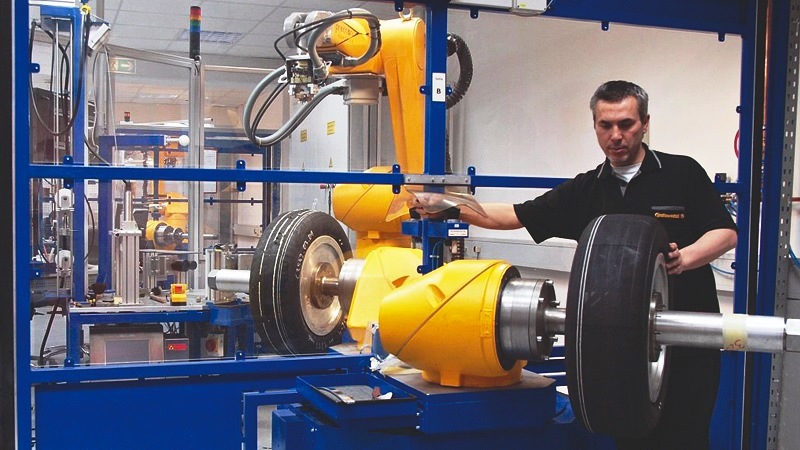
Automotive manufacturing and production of industrial robots (Source: IFR/ Staubli)
Santagate said: "Those are new technologies, but additional technologies -- such as machine learning, smart features, industrial IoT linking, and predictive maintenance capabilities due to linking capabilities. Some robots;" Another prediction from IDC is that by 2021, there will be intelligent robotics agents responsible for supervising industrial robots and increasing their overall efficiency by 30%.
Another report published by Allied Market Research last year (Industrial Robotics Market Report) predicts that the global industrial robot market will grow from $27 billion in 2012 to $41 billion in 2020, and composites between 2013 and 2020. The average annual growth rate (CAGR) is 5.4%.
Although auto manufacturing is still the largest industrial robot application area, analysts expect growth in this market to slow down, CAGR will fall to about 4.9% in 2013-2020; the reason is that the global auto industry has been sluggish in the past few years. While the demand for robots in the food/beverage manufacturing sector is growing rapidly, it is estimated that the CAGR of the application market will reach 6.9% during the same period.
A new experience of true wireless
Automatic seconds connection, can be used with headphones
Professional sound engineering technology
Case Cube/acoustic clear sound reproduction
customized stainless steel acoustic structure, high quality grahene hoop system and obvious environmental noise attenuation will open up a pleasant journmey journey for you to enjoy the sound.
Built-in microphone/ Effective noise reduction/ Clear call/ Easy to carry
Sports can't be abandoned more freely
Close ergonomic design, close to the ear, even wearing for a long time can also enjoy comfortable experience.
And can form a triangular stable support with the ear, even if running and riding, vigorous fitness is still close to the ears, wildly shake off.
Bluetooth Earbuds,True Wireless Earbuds,Wireless In Ear Gaming Headset,Wireless Bluetooth Headphones
Guangzhou HangDeng Tech Co. Ltd , http://www.hangdengtech.com